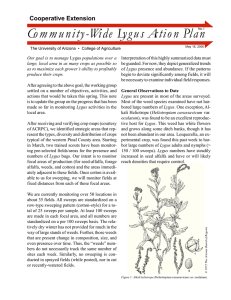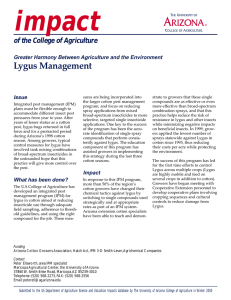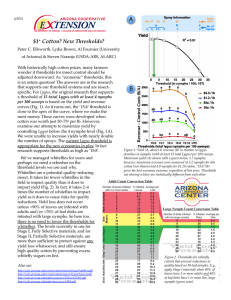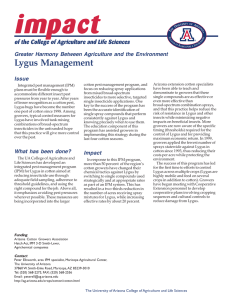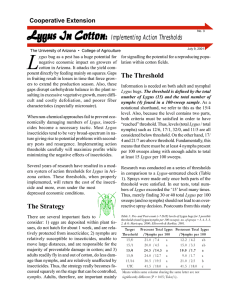Lygus
advertisement
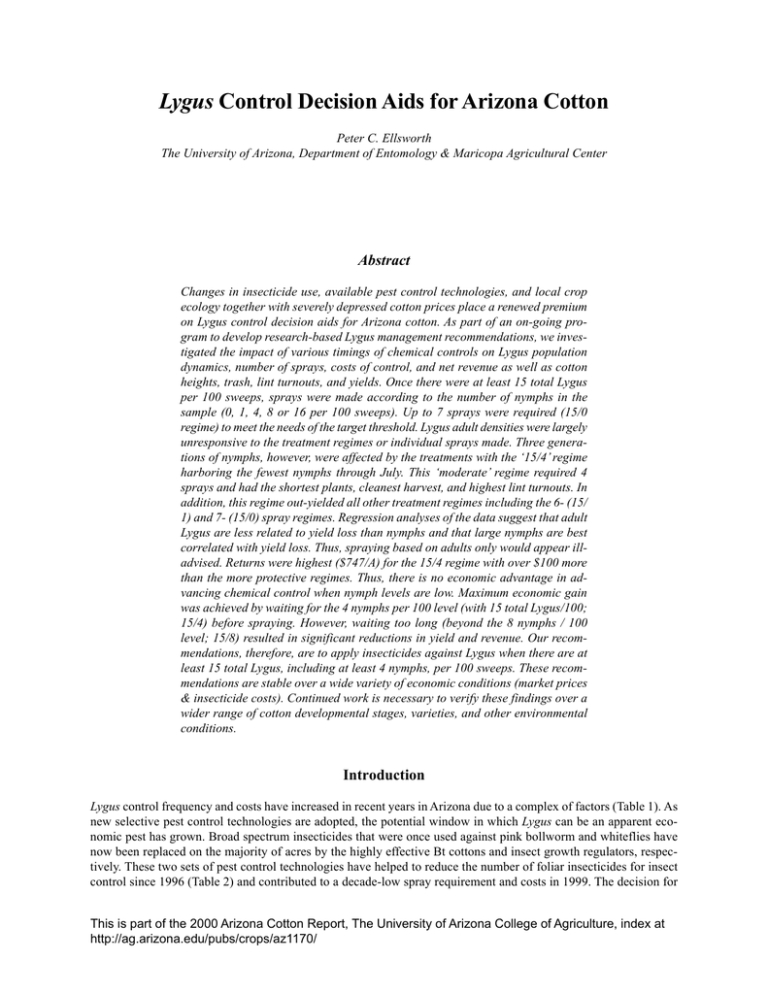
Lygus Control Decision Aids for Arizona Cotton Peter C. Ellsworth The University of Arizona, Department of Entomology & Maricopa Agricultural Center Abstract Changes in insecticide use, available pest control technologies, and local crop ecology together with severely depressed cotton prices place a renewed premium on Lygus control decision aids for Arizona cotton. As part of an on-going program to develop research-based Lygus management recommendations, we investigated the impact of various timings of chemical controls on Lygus population dynamics, number of sprays, costs of control, and net revenue as well as cotton heights, trash, lint turnouts, and yields. Once there were at least 15 total Lygus per 100 sweeps, sprays were made according to the number of nymphs in the sample (0, 1, 4, 8 or 16 per 100 sweeps). Up to 7 sprays were required (15/0 regime) to meet the needs of the target threshold. Lygus adult densities were largely unresponsive to the treatment regimes or individual sprays made. Three generations of nymphs, however, were affected by the treatments with the ‘15/4’ regime harboring the fewest nymphs through July. This ‘moderate’ regime required 4 sprays and had the shortest plants, cleanest harvest, and highest lint turnouts. In addition, this regime out-yielded all other treatment regimes including the 6- (15/ 1) and 7- (15/0) spray regimes. Regression analyses of the data suggest that adult Lygus are less related to yield loss than nymphs and that large nymphs are best correlated with yield loss. Thus, spraying based on adults only would appear illadvised. Returns were highest ($747/A) for the 15/4 regime with over $100 more than the more protective regimes. Thus, there is no economic advantage in advancing chemical control when nymph levels are low. Maximum economic gain was achieved by waiting for the 4 nymphs per 100 level (with 15 total Lygus/100; 15/4) before spraying. However, waiting too long (beyond the 8 nymphs / 100 level; 15/8) resulted in significant reductions in yield and revenue. Our recommendations, therefore, are to apply insecticides against Lygus when there are at least 15 total Lygus, including at least 4 nymphs, per 100 sweeps. These recommendations are stable over a wide variety of economic conditions (market prices & insecticide costs). Continued work is necessary to verify these findings over a wider range of cotton developmental stages, varieties, and other environmental conditions. Introduction Lygus control frequency and costs have increased in recent years in Arizona due to a complex of factors (Table 1). As new selective pest control technologies are adopted, the potential window in which Lygus can be an apparent economic pest has grown. Broad spectrum insecticides that were once used against pink bollworm and whiteflies have now been replaced on the majority of acres by the highly effective Bt cottons and insect growth regulators, respectively. These two sets of pest control technologies have helped to reduce the number of foliar insecticides for insect control since 1996 (Table 2) and contributed to a decade-low spray requirement and costs in 1999. The decision for This is part of the 2000 Arizona Cotton Report, The University of Arizona College of Agriculture, index at http://ag.arizona.edu/pubs/crops/az1170/ 269 use of in-season insecticides primarily depends on the presence of Lygus, Arizona’s third ‘key’ pest. Changes in local crop ecology (i.e., the availability of alternate hosts) together with severely depressed cotton prices place a renewed premium on Lygus control decision aids. Information on the relative performance of and timing in insecticide use is necessary for growers to maximize profitability. Insecticide Efficacy ‘Effective chemical use’ is one of the three keys to cotton IPM in Arizona (Ellsworth 1999b). Part of this key depends on selection of the proper insecticide. Our studies in 1999 re-enforced our current recommendations for chemical control: 1) use one of four possible insecticides (acephate [e.g., Orthene®], endosulfan [e.g., Thiodan®], Monitor, Vydate) at appropriate rates, and 2) avoid the use of pyrethroids which remain ineffective or combinations which have not been proven to be the most profitable option (Diehl et al. 1998; Ellsworth & Diehl 1998; Ellsworth et al. 1998a; Ellsworth 1999a). Another part of this key is resistance management (Ellsworth 1998a). Ample evidence exists to suggest that Lygus can and do become locally resistant to overused insecticides (Dennehy & Russell 1996; Dennehy et al. 1998). Thus in Arizona cotton, we suggest limiting the use of each active ingredient, no matter the insect target, to no more than two uses per season and rotating among classes of chemistry or modes of action (Ellsworth et al. 1996). This is very difficult, if not impossible, to do for Lygus in areas of repeated need for chemical control (e.g., near Lygus sources), especially given that the four recommended insecticides may represent as few as two functional modes of action (i.e., organophosphates / carbamate & cyclodiene). The new class neonicotinoid, which has shown some promise on the eastern species, Lygus lineolaris, so far has not proven effective against our species, Lygus hesperus. Only one new insecticide with pending registration shows consistent promise for the control of Lygus in Arizona (Ellsworth et al. 1998a; ACGA 1999; Ellsworth 1999a; Ellsworth et al. 1999). Fipronil (Regent® by Aventis) is a new class of insecticide with registrations in rice and corn in the U.S. and cotton in Mexico. Thresholds Timing of insecticide use (i.e., thresholds) may be the most important part of ‘effective chemical use’ and managing Lygus profitably. In addition to the recent shift in cotton prices and in use of selective pest control technologies, cotton varieties and cultural practices have shifted towards a more determinant, compact fruiting cycle. These changes demand a re-evaluation of our guidelines for Lygus control thresholds. This re-evaluation began in 1997 (Ellsworth 1998b; Ellsworth et al. 1998a) and was continued in 1999 with the replicated timing trial reported here. Methods A set of 5 candidate action thresholds and an untreated check (Table 3) were evaluated for their impact on Lygus population dynamics, number of sprays, costs of control, plant heights, lint turnouts and yield, and net revenues. The test was planted to NuCOTN 33b (13 April) and oversprayed with one application each of Knack® (10 August) and Applaud® (1 September). This strategy eliminated the confounding effects of pink bollworm (and other lepidopterans) and whiteflies, the two other ‘key’ pests of Arizona cotton. Pix® (1 pt/A) was oversprayed on the entire test once (16 July). The Lygus insecticides were rotated among Orthene (1 lb ai/A), Vydate (1 lb ai/A), and Regent (0.05 lb ai/ A) (Fig. 1). Endosulfan was not selected because of its additional impact on whitefly (esp. adults) control. This test system provided for a rare opportunity in field designs to isolate the impact of a single, yield-limiting pest without the confounding effects of other pests or other pesticides. The thresholds were defined by the number of Lygus per 100 sweeps. Prior studies had shown that adult counts were relatively refractory to insecticide sprays (Ellsworth et al. 1998a; Pacheco 1998; Ellsworth 1999a), so thresholds were defined primarily by the presence or number of nymphs in this study. For each threshold, at least 15 total Lygus per 100 sweeps had to be present no sooner than 6 days after the last spray. T1–T5 were then distinguished as having 0, 1, 4, 8 or 16 nymphs per 100 sweeps, respectively (Table 3). All sprays were made within 24 hrs of the indicating sample, rain and irrigation water permitting. All sprays were made by ground, broadcast, two nozzles per row (TeeJet Twinjet® 8003EVS) at 20 GPA with a John Deere modified Hi-Cycle 600A. In order to better understand the relative yield differences observed, linear regressions were needed to further explore Lygus density:yield relationships. But because sprays were made according to candidate action thresholds, Lygus 270 numbers among treatments could not be directly compared without considering the number of days post-treatment. Thus, a measure of Lygus-days was calculated for each treatment where the number of Lygus on sample date n+1 were divided by the number of days in the sampling interval [days(n+1)-days(n)] and then accumulated for each sample date. This provided a running total of Lygus-days for each stage and threshold for use in determining relationship to yields by linear regression techniques. Seed cotton was machine-picked from two, 2-row subsamples and weighed. Grab samples were selected at random from each subsample and ginned in a one third, commercial-scale research gin. Lint and seed fractions were collected and weighed, and turnouts calculated for each subsample. Individual turnouts were used to derive yield estimates for each plot and reported as no. of 480 lb bales / A. Statistics were performed on normalized data, where possible, including ANOVA with appropriate, pre-planned, orthogonal contrasts using JMP® Software (SAS, 1995). HVI fiber measurements will be reported elsewhere. Results & Discussion Lygus Population Dynamics Total Lygus numbers were only rarely below the 15 level for the entire sampling period (24 June – 31 August) regardless of treatment regime (Fig. 2). This was typical of the area and reflected the high densities of Lygus locally. Adult Lygus were least responsive to the insecticides and thresholds used much like previous studies (Fig. 3) (Ellsworth et al. 1998a; Pacheco 1998; Ellsworth 1999a). A marked decline of adults was noted during the period of 19–23 July even in the UTC. This appeared to be the result of a synchronous senescence of adults that arrived in the field ca. 3 weeks earlier, but also may have been related to increased intensity in monsoon related weather around that time (i.e., dust, wind & rain). Total nymph numbers were more responsive in general to insecticide treatments (Fig. 4). In general, the less reactive regimes (i.e. higher thresholds) sustained more nymphs. One exception was in the ‘15/4’ regime which had significantly fewer nymphs than all other, even more reactive, regimes through most of the July sampling period. Partitioning nymphs between small nymphs (instars 1–3) and large nymphs (instars 4–5), several other trends were noted. A large number of small nymphs were detected during the period of 16–26 July indicating a large egg hatch prior to this (Fig. 5). A second period of small nymph activity was detected 9–19 August. Patterns of large nymph abundance indicated the occurrence of three generations of Lygus in this test with the largest being the second generation that occurred during July (Fig. 6). Large nymph numbers were lowest for the 15/4 regime and at 0 per 100 sweeps from 13 July (3 days after first treatment [DAT1]) through 2 August (7 DAT3). Plant Responses & Yield Lygus bugs impact plants principally through damage to squares. These squares may then ‘flare’ and later drop from the plant. This causes a disruption in the source-sink relationship of available carbohydrates produced through photosynthesis for boll development. The result can be plants with energy directed towards mainstem elongation (e.g., rank plants) rather than yield. Plant height was not significantly different among any of the sprayed regimes; however, the UTC plants were significantly taller (ca. 6 cm) than the others (Table 4). The 15/4 regime had the shortest plants. Several recent studies have established the relationship between plant height and Lygus control efficacy or Lygus population dynamics (Ellsworth 1999a). Excessive plant height can lead to inefficient defoliation which can also affect ginning properties (Ellsworth 1999a; Ellsworth & Naranjo 1999). Trash levels in machine-picked and ginned samples were highest for the UTC (Table 4). The 15/4 regime had the least amount of trash than any other treatment, and significantly less than 15/16 regime. For lint turnouts, the 15/4 regime (36.5%) was highest and significantly higher than the UTC and even the most reactive 15/0 regime (Table 4). This represents an expensive and often hidden cost to growers (Ellsworth 1999a). Lint yields were highest for the 15/4 regime (Table 4) with significantly more yield than the more reactive 15/1 regime and less reactive 15/16 regimes. Yields ostensibly began to plateau at the 15/8 regime but began to decline at 271 the 15/1 regime. The source of this yield depression is unknown at this time, but is consistent with past experiments (Ellsworth 1998b; Ellsworth et al. 1998a). It counters the generalized philosophy of growers and pest control advisors that being a little ‘early’ with a spray costs no more potentially than the cost of that spray. In fact, both of the more reactive regimes had more and earlier sprays than the 15/4 regime, yet both yielded less. No. of Sprays, Control Costs & Returns The most reactive regime, 15/0, required a total of 7 sprays, while the least reactive regime, 15/16, required only 2 sprays (Table 3). Control costs were determined by average market conditions in central Arizona during the application period of interest. Because Regent is not currently marketed in cotton, the cost of this compound was fixed at 13.50$/A based on economic analyses performed for an AZ Section 18 petition in 1999 (ACGA 1999). Application costs were fixed at $5/A. Control costs ranged from 120.51 – 34.75 $ / A (Table 3). The highest cost is more than double the statewide average for 1998 which was widely considered one of the worst ‘Lygus years’ of the decade. The lowest control cost is somewhat above the statewide average for Lygus control in 1999, widely considered one of the lowest ‘insect pest years’ of the decade if not history (Table 1). In spite of this, control costs for Lygus in the local Maricopa area were as high as $240/A in 1999. Returns (yield @ 50¢/lb - control costs) were highest for the 15/4 regime and significantly higher than all other regimes except the less reactive 15/8 regime (Table 4). Once again, this debunks the protective strategy which suggests that there is no penalty for ‘early’ or more reactive control. To examine the sensitivity of this relationship to cotton price fluctuations, we calculated returns based on prices ranging from 20¢/lb to $1.20/lb (Fig. 7). As the price increases beyond this upper limit, the 15/0 regime becomes statistically similar to the 15/4 regime; however, as the price declines to 20¢/lb, the 15/0 regime returns less money than any other regime (Fig. 8). Sensitivity to control costs was also examined by varying the costs of controls by -50% and 200%. By cutting cost of control by -50%, there was no change in the relative ranking or significance of returns; however, an increase by +50% resulted in the lowest net return for the 15/0 and 15/1 regimes. Thus, any increases in control costs should further favor the more moderate 15/4 regime. Lygus Density : Yield Relationships Cumulative ‘Lygus-days’ were best correlated with yield on 17 August (i.e., Lygus-days accumulated from 7 July through 17 August) (Table 5). This corresponds well with the end of the primary fruiting cycle. Adult levels were always poorly correlated with yields (max. R2=0.36). Given that chemical control of this stage is poor at best, this result is not surprising. However, the large differences in yield detected (over 2.4 bales) would seem to implicate nymphs as the primary yield-reducing stage of Lygus. The best correlated cumulative measure of Lygus density was Lygus nymph-days (R2=0.82; Table 5) further suggesting the important relationship between nymphs and yield. Of the nymphal stage, large nymphs (instars 4 & 5) provided the highest correlation coefficients for yield (R2=0.75; Table 5). Conclusions Clearly, there is no economic advantage in advancing chemical control when nymph levels are very low. Instead, maximum economic gain was achieved by waiting until there were at least 15 total Lygus / 100 sweeps with at least 4 nymphs (‘15/4’ regime). Also clear, control cannot be delayed beyond the 8 nymphs per 100 level (‘15/8’) without significant reductions in yield or revenue. These findings re-enforce past studies that found in addition to yield loss, Lygus are responsible for excessive plant height, difficult defoliation, more lint trash, and less lint turnout. These are the hidden losses that growers face in their bottom line. More attention in management and research is needed on the specific role nymphs play in defining the relationship to yields and revenue. For now, it would be prudent and most profitable to conduct detailed and frequent Lygus monitoring (at least 100 sweeps / average-sized field) and initiate sprays whenever nymph levels exceed 4 / 100 (with a total of 15–20 Lygus / 100 sweeps). These threshold recommendations are stable over a wide range of market conditions 272 (cotton prices & insecticide costs). However, further testing will be necessary to properly define the relationship of these threshold densities to cotton’s dynamic fruiting period. For example, the need for control of Lygus, at any density, once bolls are set is doubtful (i.e., at or beyond crop cut-out). These recommendations are consistent with, yet more specific than, University guidelines of the last several years (Diehl et al. 1998; Ellsworth & Diehl 1998; Ellsworth 1999a; Ellsworth & Naranjo 1999). Acknowledgments The author has been engaged in Lygus management research and supported by various sources during the past five years; however, special thanks are due to the major sponsors including the Arizona Cotton Growers Association and the State Support Committee of Cotton Incorporated, Arizona Cotton Research & Protection Council, The University of Arizona IPM Program, DuPont, Rhône-Poulenc, Valent, and others in the agrichemical industry. I would also like to thank S. Naranjo (USDA-ARS, WCRL) who collaborated on elements of this research and has provided input on all aspects of experimentation, and J. Pacheco (DuPont) whose research and discussions have helped shape the current work. Most of all, the author would like to thank Virginia Barkley and the rest of his dedicated staff who have worked on all elements of the research and extension cited here. Disclaimer Any products, services, or organizations that are mentioned, shown, or indirectly implied in this paper do not imply endorsement by The University of Arizona. References Arizona Cotton Growers Association [P.C. Ellsworth, ed.]. 1999. Arizona Section 18 Request for Regent® against Lygus in Cotton. 26 pp. http://ag.arizona.edu/cotton/regent18.pdf * Dennehy, T.J. & J.S. Russell. 1996. Susceptibility of Lygus bug populations in Arizona to acephate (Orthene®) and bifenthrin (Capture®), with related contrasts of other insecticides. In P. Dugger & D. Richter [ed.], Proceedings. Beltwide Cotton Conferences, Cotton Insect Research and Control Conference, Nashville, TN. pp. 771–777. Dennehy, T.J., J.E. Russell, L. Antilla & M. Whitlow. 1998. New insights regarding estimating Lygus susceptibility to insecticides. In P. Dugger & D. Richter [ed.], Proceedings. Beltwide Cotton Conferences, Cotton Insect Research and Control Conference, San Diego, CA. pp. 1255–1259. Diehl, J.W., P.C. Ellsworth & L. Moore. 1998. “Lygus in Cotton No. 1: Identification, Biology & Management.” The University of Arizona Cooperative Extension, 2 pp. (7/98)* Ellsworth, P.C. 1998a. Susceptibility management of Lygus in the West. In P. Dugger & D. Richter [ed.], Proceedings. Beltwide Cotton Conferences, Cotton Insect Research and Control Conference, San Diego, CA. pp. 955–957. Ellsworth, P.C. 1998b. Integrated Lygus management in Arizona. In J.C. Silvertooth [ed.], Cotton, A College of Agriculture Report. Series P-112. University of Arizona, College of Agriculture, Tucson, AZ. pp. 403–407.* Ellsworth, P.C. 1999a. Evaluation of chemical controls of Lygus hesperus in Arizona. In J.C. Silvertooth [ed.], Cotton, A College of Agriculture Report. Series P-116. University of Arizona, College of Agriculture, Tucson, AZ. pp. 428–447.* Ellsworth, P.C. 1999b. Whitefly management in Arizona cotton — Status and needs. In P. Dugger & D. Richter [ed.], Proceedings. Beltwide Cotton Conferences, Sticky Cotton Progress, Orlando, FL. pp. 41–43. 273 Ellsworth, P.C. & J.W. Diehl. 1998. “Lygus in Cotton No. 2: An Integrated Management Plan for Arizona.” The University of Arizona Cooperative Extension, 2 pp. (7/98)* Ellsworth, P.C. & S.E. Naranjo. 1999. Whitefly management with insect growth regulators and the influence of Lygus controls. In J.C. Silvertooth [ed.], Cotton, A College of Agriculture Report. Series P-116. University of Arizona, College of Agriculture, Tucson, AZ. pp. 339–354.* Ellsworth, P.C., T.J. Dennehy & R.L. Nichols. 1996a. Whitefly Management in Arizona Cotton 1996. IPM Series No. 3. The University of Arizona, Cooperative Extension. Publication #196004. Tucson, AZ. 2 pp.* Ellsworth, P.C., R. Gibson, D. Howell, S. Husman, S. Stedman & B. Tickes. 1998a. Lygus chemical control: Are combination sprays worth it? In J.C. Silvertooth [ed.], Cotton, A College of Agriculture Report. Series P-112. University of Arizona, College of Agriculture, Tucson, AZ. pp. 408–421.* Ellsworth, P.C., B. Deeter & M. Whitlow. 1999. EUP evaluation of a novel insecticide for Lygus control. In J.C. Silvertooth [ed.], Cotton, A College of Agriculture Report. Series P-116. University of Arizona, College of Agriculture, Tucson, AZ. pp. 459–467.* Pacheco, J.L. 1998. A five year review of Lygus efficacy and cotton yield studies in central Arizona. In P. Dugger & D. Richter [ed.], Proceedings. Beltwide Cotton Conferences, Cotton Insect Research and Control Conference, San Diego, CA. pp. 984–992. SAS, 1995. *Denotes items that are also available on the internet at: ag.arizona.edu/cotton, a site sponsored in part by the National Center for IPM and the UA IPM program. Table 1. Arizona statewide average number of sprays and costs of control made for Lygus control (1990–1999). Year 1990 1991 1992 1993 1994 1995 1996 1997 1998 1999 Applications Cost of % of Total Yield % of Total Crop Loss (No. / A) Control ($/A) Insect Control Reduction (%) Insect Losses ($ millions) 1.90 3.30 0.50 0.20 1.20 2.30 1.26 2.10 2.76 1.02 17.10 33.00 5.00 2.60 14.40 27.60 25.25 37.67 55.20 19.98 15.0 31.4 4.1 3.7 10.4 12.8 22.7 35.0 53.4 53.7 0.95 1.64 0.12 0.50 4.81 6.08 4.75 2.63 7.00 3.32 274 15.8 51.6 1.2 11.3 45.5 70.1 47.5 41.4 78.3 72.8 2.9 5.8 0.3 1.3 10.6 17.4 16.2 8.4 16.4 7.6 Table 2. Arizona statewide average number of sprays and costs of control for all arthropod pests (1990–1999). Bt transgenic cotton (for pink bollworm control) and insect growth regulators (for whitefly ocntrol) were introduced to the state in 1996. Year No. of Foliar Sprays Costs ($/A) 1990 1991 1992 1993 1994 1995 1996 1997 1998 1999 11.50 9.90 7.70 3.90 9.00 12.50 5.69 5.33 4.68 1.91 113.76 105.09 122.96 69.90 138.57 215.06 111.20 107.53 103.38 37.18 Table 3. Candidate thresholds used in Lygus control test in Maricopa, AZ, 1999. Treatment Names Threshold1 Sprays2 Cost3 T1; 15/0 T2; 15/1 T3; 15/4 T4; 15/8 T5; 15/16 ≥ 15 total; 0 nymphs 7; 6/30 120.51 ≥ 15 total; 1 nymph 6; 6/30 105.5 ≥ 15 total; 4 nymphs 4; 7/10 67.75 ≥ 15 total; 8 nymphs 3; 7/16 52.75 ≥ 15 total; 16 nymphs 2; 7/19 34.75 T6; UTC — 0 0 1 Total no. of Lygus per 100 sweeps and No. of nymphs per 100 sweeps. Both criteria, adult & nymph levels, were met prior to each spray. 2 Number of Lygus sprays and initiation date for each threshold regime. 3 $/A, including application costs. UTC = Untreated Check Table 4. Plant measurements by treatment1. Threshold 15/0 se 15/1 se 15/4 se 15/8 se 15/16 se UTC se Height (cm) 121.31 3.96 120.31 5.03 118.44 1.64 126.56 5.33 126.81 2.90 142.63 4.38 a a a a a b Trash (%) 9.42 0.57 7.73 0.41 7.08 0.80 9.49 1.80 9.88 0.61 13.84 0.65 Turnout (%) ab 34.70 0.37 35.52 0.08 36.60 0.61 36.14 0.70 35.96 0.40 33.41 0.48 ab a ab b c 1 bc ab a ab ab c Bales/A 3.20 0.16 3.10 0.11 3.40 0.07 3.20 0.10 2.67 0.12 0.98 0.05 ab b a ab c d Return ($/A) 641.80 37.51 634.34 26.40 746.60 16.80 712.41 23.39 605.00 28.22 234.78 11.62 bc c a ab c d Treatments means (transformed) separated by orthogonal contrasts (P=0.05). Means within a column that share a letter are not significantly different from each other. UTC = Untreated Check se=standard error of the mean 275 Table 5. ‘Lygus-days’ accumulated from 6 July to 17 August1. Threshold Small Nymphs / 100 15/0 se 15/1 se 15/4 se 15/8 se 15/16 se UTC se R2 0.44 0.31 0.90 0.07 0.58 0.34 0.67 0.20 0.96 0.50 2.26 0.44 0.55 Large Nymphs / 100 a 0.90 0.53 1.10 0.34 0.64 0.25 1.53 0.79 1.58 0.43 4.76 0.56 0.75 a a a a b All Nymphs / 100 Adults / 100 Total Lygus / 100 1.35 0.82 2.01 0.30 1.23 0.55 2.20 0.90 2.54 0.70 7.02 0.45 0.82 11.48 1.36 10.54 1.63 12.26 1.14 12.26 1.90 13.41 2.85 15.63 ns 1.59 0.13 12.83 2.06 12.54 1.42 13.49 1.41 14.46 2.30 15.95 2.89 22.65 1.35 0.50 a a a a a b a a a a a b a a a a a b 1 Treatments means (transformed) separated by orthogonal contrasts (P=0.05). Means within a column that share a letter are not significantly different from each other. 2 2 R , for linear regression for Lygus-days on yield. The highest correlation was for All Nymphs/100 sweeps. UTC = Untreated Check ns = not significant se=standard error of the mean 7 UTC 6 Threshold O 15/8 15/4 O V 15/1 O V R 15/0 O V R V V O O R 5 R 4 R 3 V R O V Treatment O 15/16 2 O 1 0 27-Jun 4-Jul 11-Jul 18-Jul 25-Jul 1-Aug 8-Aug 15-Aug 22-Aug Figure 1. Insecticide sequence & timing for each candidate threshold. O = Orthene (1 lb ai/A); V = Vydate (1 lb ai/A); R = Regent (0.05 lb ai/A). 276 Total Lygus (100 sweeps) 105 ❶ ❷ 90 ❶ ❷ ❸ ❶ ❷ ❸ ❹ 75 * * * * ❷ ❶ ❸ ❶ ❷ ❶ ❷ ❹ ❺ ❸ ❹ * * * * 4 5 UTC T5 5 T4 4 3 T3 1 T1 2 ❶ ❺ 60 5 45 3 2 3 5 4 30 1 5 3 4 2 1 2 1 2 3 4 5 15 0 1 2 3 4 5 3 21 1 5 1 2 4 3 2 5 4 5 3 3 1 2 2 5 4 2 51 5 3 4 5 4 3 2 21 1 9-Jul 4 1 2 3 4 2 1 3 3 18-Jun 25-Jun 2-Jul 5 5 31 2 T2 16-Jul 23-Jul 30-Jul 6-Aug 13-Aug 20-Aug 27-Aug 3-Sep Figure 2. Number of total Lygus per 100 sweeps in response to 5 different timings of chemical control and an UTC, Maricopa, AZ. Large numbered circles near the top of the chart indicate the treatment numbers and timing of associated sprays (i.e., threshold regimes) (see Table 3). There were significant differences in Lygus counts among threshold regimes (numbered lines) for the dates indicated (‘*’): 7/22, 7/26, 8/4, 8/13, 8/17, 8/19, 8/24, 8/31. * Adults (100 sweeps) 60 ❶ ❷ 50 ❶ ❷ ❸ 40 3 4 5 ❶ ❷ ❸ ❹ * * ❺ ❶ ❷ ❸ ❹ ❶ ❷ ❸ ❹ ❶ ❷ * ❶ ❺ 2 3 1 1 30 20 10 3 4 5 2 2 5 2 4 31 21 3 4 5 21 1 3 4 5 2 3 1 5 3 0 9-Jul 5 3 4 2 1 2 5 3 2 5 21 5 4 3 2 5 18-Jun 25-Jun 2-Jul 4 4 3 4 5 1 2 5 5 5 4 1 1 41 2 T4 UTC T5 5 T1 1 4 T3 3 2 T2 1 3 2 2 3 3 16-Jul 23-Jul 30-Jul 6-Aug 13-Aug 20-Aug 27-Aug 3-Sep Figure 3. Number of Lygus adults per 100 sweeps in response to 5 different timings of chemical control and an UTC, Maricopa, AZ. Large numbered circles near the top of the chart indicate the treatment numbers and timing of associated sprays (i.e., threshold regimes) (see Table 3). There were significant differences in Lygus counts among threshold regimes (numbered lines) for the dates indicated (‘*’): 7/16, 8/17, 8/19, 8/24. 277 * Nymphs (100 sweeps) 60 ❶ ❷ ❶ ❷ ❸ 48 ❶ ❷ ❸ ❹ ❺ * * ❶ ❷ ❸ ❹ ❶ ❷ * ❸ ❹ * * ❶ ❷ * * ❶ ❺ 36 5 5 24 1 1 5 2 4 12 21 3 4 5 0 21 3 4 5 3 2 1 3 5 2 3 41 18-Jun 25-Jun 2-Jul 2 5 5 3 3 3 2 1 3 4 9-Jul 2 21 4 5 4 5 2 1 3 2 5 3 4 2 4 3 5 1 4 3 2 5 1 2 1 4 5 3 21 51 3 4 2 UTC T5 5 T4 4 3 T3 2 T2 T1 1 16-Jul 23-Jul 30-Jul 6-Aug 13-Aug 20-Aug 27-Aug 3-Sep Small Nymphs (100 sweeps) Figure 4. Number of Lygus nymphs per 100 sweeps in response to 5 different timings of chemical control and an UTC, Maricopa, AZ. Large numbered circles near the top of the chart indicate the treatment numbers and timing of associated sprays (i.e., threshold regimes) (see Table 3). There were significant differences in Lygus counts among threshold regimes (numbered lines) for the dates indicated (‘*’): 7/22, 7/26, 8/4, 8/9, 8/13, 8/17, 8/24, 8/31. 35 ❶ ❷ 30 ❶ ❷ ❸ ❶ ❷ ❸ ❹ 25 * ❷ ❹ ❺ * ❶ ❶ ❷ ❸ ❸ ❹ ❶ ❷ * * * ❶ ❺ 20 5 15 10 5 0 T5 UTC 1 5 2 4 3 21 3 4 5 18-Jun 25-Jun 1 2 2 3 4 5 1 3 2-Jul 2 31 4 5 2 9-Jul 5 2 31 4 3 5 1 3 21 5 3 4 5 5 5 2 4 1 2 3 4 3 2 4 3 5 2 1 4 5 2 1 3 4 2 1 5 4 5 3 12 4 5 3 21 3 2 1 T4 T3 T2 T1 16-Jul 23-Jul 30-Jul 6-Aug 13-Aug 20-Aug 27-Aug 3-Sep Figure 5. Number of Lygus small nymphs (instars 1–3) per 100 sweeps in response to 5 different timings of chemical control and an UTC, Maricopa, AZ. Large numbered circles near the top of the chart indicate the treatment numbers and timing of associated sprays (i.e., threshold regimes) (see Table 3). There were significant differences in Lygus counts among threshold regimes (numbered lines) for the dates indicated (‘*’): 7/26, 8/4, 8/17, 8/19, 8/31. 278 Large Nymphs (100 sweeps) 35 ❶ ❷ 30 ❶ ❷ ❸ ❶ ❷ ❸ ❹ 25 * * ❷ ❺ ❹ ❶ ❶ ❷ ❸ * ❸ ❹ * ❶ ❷ * ❶ * * ❺ 5 20 UTC 15 1 5 10 5 0 4 2 1 5 1 2 3 4 5 2 1 21 3 4 5 18-Jun 25-Jun 3 5 3 21 4 2-Jul T4 5 3 2 9-Jul 21 3 4 5 5 4 1 5 3 4 2 5 3 4 2 1 3 2 4 T2 5 4 3 2 1 5 4 13 2 T5 T3 T1 16-Jul 23-Jul 30-Jul 6-Aug 13-Aug 20-Aug 27-Aug 3-Sep 5 2 4 1 3 3 3 5 2 2 3 21 31 5 2 4 1 Figure 6. Number of Lygus large nymphs (instars 4–5) per 100 sweeps in response to 5 different timings of chemical control and an UTC, Maricopa, AZ. Large numbered circles near the top of the chart indicate the treatment numbers and timing of associated sprays (i.e., threshold regimes) (see Table 3). There were significant differences in Lygus counts among threshold regimes (numbered lines) for the dates indicated (‘*’): 7/22, 7/26, 8/9, 8/13, 8/17, 8/24, 8/31. Revenue - Control Costs ($/A) 2000 20¢ / lb 1800 50¢ / lb 1600 80¢ / lb 1400 $1.2 / lb 1200 1000 800 600 A B A B B 400 C 200 0 15/0 15/1 15/4 15/8 15/16 UTC Thresholds Figure 7. Sensitivity of net revenue in relation to cotton prices. Highest revenues were from the 15/4 or 15/8 regimes, and this did not change over the range of prices tested. Above $1.20 per lb, the 15/0 regime became statistically similar to the 15/4 regime. 279 Revenue - Control Costs ($/A) 800 -50% 700 Market 600 +50% +100% 500 400 300 200 100 0 15/0 15/1 15/4 15/8 15/16 UTC Thresholds Figure 8. Sensitivity of net revenue in relation to cotton prices. Highest revenues were from the 15/4 or 15/8 regimes, and this did not change over the range of prices tested. However, as the control costs increased (≥ +50%), the 15/0 and 15/1 regimes yielded less returns than any other sprayed regime. 280
